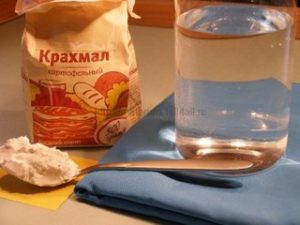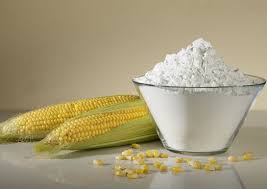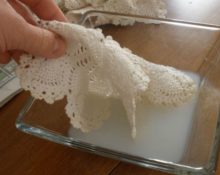Ribbons for gymnasts and bows for ceremonial hairstyles are starched so that the delicate fabric is less wrinkled and dirty. The procedure is simple, but there are subtleties.
What will you need?
The main component is starch, diluted with water. On store shelves you can find potato or corn products - both are suitable. It is recommended to make the starch solution in a small enamel container.
Important! Starch has a shelf life of two years. After they expire, it’s better to go get a new one.
How to make a solution correctly?
Satin ribbon is a lightweight, but quite strong and dense fabric that requires a small amount of starch: from one to one and a half teaspoons per liter of water is enough. The sequence of preparing the solution is as follows:
 dissolve the starch in a small amount (about half a glass) of cold water, stir well;
dissolve the starch in a small amount (about half a glass) of cold water, stir well;- pour the starch solution in a thin stream into the water that was previously placed on the fire at the boiling stage, constantly stirring in a circular motion along the sides of the container;
- After waiting for the whole mass to boil, reduce the heat to low and boil the solution for about seven minutes, without ceasing to stir;
- Having received a transparent paste, remove from heat.
Important! If water gets into the starch powder during storage, you will have to throw it away - it cannot be dried.
You can start starching.
Methods for starching satin ribbon
Before starching, the tape must be washed with a suitable product and rinsed thoroughly. The starched fabric can be dry or damp - you can also squeeze it lightly.
 We immerse the material in the prepared solution so that there are no “islands” on the surface of the paste. The fabric should remain in the starch for about twenty minutes, which is stirred periodically, allowing the fabric to be completely saturated. Then the removed tape is cleaned of excess solution by passing it between tightly clenched fingers. Do not twist! After drying in a suspended position, the ribbon must be ironed correctly - through the paper and turning off the steaming mode.
We immerse the material in the prepared solution so that there are no “islands” on the surface of the paste. The fabric should remain in the starch for about twenty minutes, which is stirred periodically, allowing the fabric to be completely saturated. Then the removed tape is cleaned of excess solution by passing it between tightly clenched fingers. Do not twist! After drying in a suspended position, the ribbon must be ironed correctly - through the paper and turning off the steaming mode.
As a result of manipulation, an additional layer is formed on the surface of the fabric, protecting against the penetration of air and dirt.
This old method of starching is time-tested and the least wasteful, but there are others. If you have doubts about the success of a self-performed procedure, you can purchase a finished product. It could be:
- liquid starch;
- aerosol.
In the first case, we proceed as in the “classic” version of starching: immerse the ribbon in the solution, take it out after ten minutes, dry it, iron it.In the second case, we spray the product from a distance of about twenty-five centimeters, trying to make the layer uniform.
Advice! Gelatin can be used as a replacement for starch: pour a tablespoon of powder with a small amount of cold water and leave to swell. Having waited for the result, add water to two hundred grams and put on low heat, heat, but do not boil. Once the gelatin has completely dissolved and cooled, you can put the tape in it.
Subtleties of starching bows and satin fabric
 When choosing between potato starch and corn starch, you need to consider the color of the tape. For light-colored products, potato is preferable - its bluish tint will not give a yellowish effect.
When choosing between potato starch and corn starch, you need to consider the color of the tape. For light-colored products, potato is preferable - its bluish tint will not give a yellowish effect.- Corn starch hardens and dries a little longer than its potato counterpart.
- High-quality starch is possible only if there are no lumps in the prepared paste. You can ensure their absence, even if the solution is not perfectly homogeneous - straining with a strainer or several layers of gauze will correct the situation.
- A solution that is too thick can be easily diluted with water at room temperature and mixed thoroughly.


 dissolve the starch in a small amount (about half a glass) of cold water, stir well;
dissolve the starch in a small amount (about half a glass) of cold water, stir well; When choosing between potato starch and corn starch, you need to consider the color of the tape. For light-colored products, potato is preferable - its bluish tint will not give a yellowish effect.
When choosing between potato starch and corn starch, you need to consider the color of the tape. For light-colored products, potato is preferable - its bluish tint will not give a yellowish effect. 0
0





